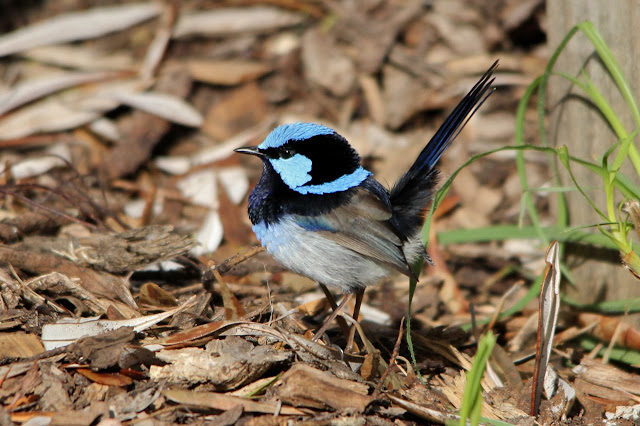We have just enjoyed a long weekend of winter sunshine in Victoria.
I didn't do any birding at the weekend but these three birds did some "peopling" by visiting the backyard at Silverleaves, Phillip Island.
 |
| Superb fairy-wren (male). I was interested to see such a brightly coloured male at this time of year (our winter). Do click on the images to follow the larger versions of these thumbnails. |
 |
| The female Superb fairy-wren is often referred to as a Jenny-wren |
 |
| Eastern spinebill (Adult male) |
The Eastern spinebill (Acanthorhynchus tenuirostris) is a handsome honeyeater of eastern Australia. This one was demonstrating its ability to hover briefly while feeding (not captured unfortunately!). The last image of the spinebill was taken through a flywire screen. The only reason it has been included is that where the sunlight reflects off the bird's eye, the flywire has created a cross-shaped flare!
The spectacle I enjoyed most was watching this Red-browed finch Neochmia temporalis.
 |
| Red-browed finch, Silverleaves, Phillip Island, Vic |
One became two ....
Two became three, which soon became four ...
Here is a photo showing 10 of the 15 birds I counted.
 |
| Red-browed finch |
The other red object in the shot above serves to remind that the photo was taken in the Australian Rules Football-mad state of Victoria. This reminds me of the excellent start to the weekend as Friday night was spent at the footy. My son and I travelled with interstate rellos Banjo and Richard (of Richard Waring's Birds of Australia fame) to the MCG witnessing a great game between Essendon and Carlton.
 |
| The teams warm up at the "G". Thanks Rich for a great night and a fun result! |
 |
| The footy experience continued with a half time kick at the local country game on Saturday (Phillip Island) |
GO BOMBERS & Bird on!
Sharing with Wild Bird Wednesday











Wow! A whole series of beautiful birds like that coming in to the backyard. Wish it happened like that more often. Great photos - I especially like the Spinebill.
ReplyDeleteGreat to see your wrens, eastern spine bills and finches. With my Hew Holland honeyeaters indulging themselves in territorial squabbles as through it were spring, your wrens have also put on their mating finery. Understandable if you already have flowering callistemon. Nature here on the farm in SA is behaving as though it were spring, bulbs coming up 4 months early and I have heard the same from Canberra.
ReplyDeleteVery beautiful shots and I love that you had a great boy's night out.
Thanks Arija,
DeleteI was trying to remember whether the shrub was a callistemon or melaleuca! It is of course a planted native not indigenous to our area but much used in gardens here and isn't it a favourite of competing honeyeaters!?
you picked up some of my favourite little birds Pete; great captures
ReplyDeleteWow....Pete, you most definitely live in a wonderful area of the world for some awesome birding!! Beautiful...each and every photo!
ReplyDeleteBlack Bellied Whistling Ducks
Close game!
ReplyDeleteThe fairywrens are splendid - I got some shots of a family group (I assume), but there was only a hint of blue in a few tails.
Also saw Red-browed and Spinebills! Although I did not get pictures of them.
Cheers - and thanks for linking to WBW - Stewart M
Beautiful series birds.
ReplyDeleteThe first three I love this.
This species is not in Netherlands.
Regards, Irma
Beautiful little birds!
ReplyDeleteI was known as Jenny Wren by my next door neighbours for many years - despite definitely not been small or petite! Beautiful shots - your winter looks far sunnier than our summer is at the moment!
ReplyDeleteSplendid photos Pete. When do the fairy wrens acquire their breeding colors? When do they lose them? I hope to make it to Australia someday and I have no idea what time of year would be the optimal time to see the birds at their best.
ReplyDeleteHi John, It's a big country with varying fairy-wren species and seasons! Down our way this fairy-wren is the most common with adult males most likely to be in breeding plumage from September to March.
DeletePeter
I love your photos of the Superb Fairy-Wrens and the Red-browed Finches are so cute.
ReplyDeleteWow!! Love your Superb Fairy-wren shots, Pete!! And the Red-browed Finches are gorgeous too!
ReplyDeleteI'd love to see an Eastern Spinebill. What a gorgeous bird!!
(Lizs_b from IG)
The Fairy Wren to me has to be one of the most spectacular birds anywhere and the images that you shared are just wonderful, along with your other shares~
ReplyDeleteThat is some species list to be visiting the yard where you stayed, stunning birds
ReplyDeleteGreat series.
ReplyDelete